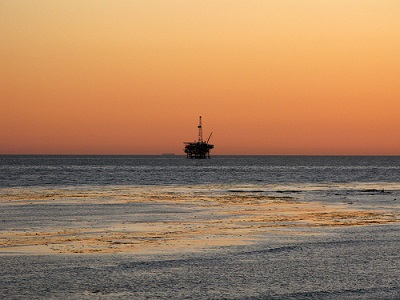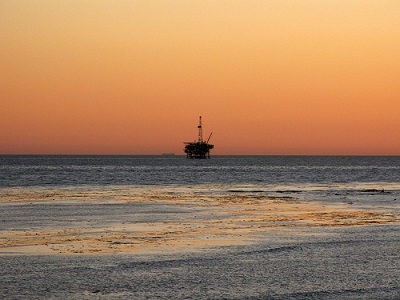
Part of the Series
Gas Rush: Fracking in Depth
 Willem van Bergen / Flickr)” width=”400″ height=”300″ style=”margin: auto; width: 100%;” />Santa Barbara sunset. (Photo: Willem van Bergen / Flickr)The Environmental Protection Agency (EPA) issued a new rule last week requiring oil and gas firms that use fracking technology in federal waters off the coast of southern California to regularly report the volume and chemical makeup of any fracking fluids or wastewater dumped into the ocean.
Willem van Bergen / Flickr)” width=”400″ height=”300″ style=”margin: auto; width: 100%;” />Santa Barbara sunset. (Photo: Willem van Bergen / Flickr)The Environmental Protection Agency (EPA) issued a new rule last week requiring oil and gas firms that use fracking technology in federal waters off the coast of southern California to regularly report the volume and chemical makeup of any fracking fluids or wastewater dumped into the ocean.
The EPA said it issued the new requirements to gather information on the chemicals discharged into the ocean during offshore fracking operations. Regulators, state lawmakers, environmental groups and the California Coastal Commission had expressed concerns to the EPA that the dumping of fracking fluids could be impacting marine environments.
The groups took action after a Truthout investigation revealed that federal regulators had approved several fracking operations off the California coast in recent years.
The new rule also requires offshore frackers and rig operators to maintain an inventory of chemicals used during certain phases of production. This inventory must be made available to the EPA upon request, and the EPA is free to enhance its regulations if new information indicates that fracking fluids are harming the environment.
Environmentalists hope the new EPA requirements will shed some light on the chemical makeup of fracking fluids, which are forced underground at high pressure to break up rock and release oil and gas. They say the new reporting rule, however, does not go far enough.
“The new reporting rule is a step in the right direction, but the oil companies shouldn’t be allowed to dump toxic fracking chemicals in the ocean at all,” said Miyoko Sakashita, the oceans director at the Center for Biological Diversity.
The public knew little about the use of fracking technology off the coast of California until July 2013, when a Truthout investigation revealed that federal regulators had permitted several fracking operations in federal waters. The regulators made minor modifications to existing drilling permits to approve the frack jobs. These modifications were “categorically excluded” from extensive environmental impact reviews, giving ocean fracking a free pass from impact analysis that environmentalists say should be required under federal law.
The ocean fracking revelations caused a general uproar in California. State lawmakers demanded a federal investigation, and the state coastal commission launched its own investigation into offshore fracking. The Center for Biological Diversity threatened to take legal action if federal regulators failed to conduct a comprehensive review of the potential environmental impacts of offshore fracking, which environmentalists say is required under federal law.
The center has won lawsuits on similar grounds in the past, but has yet to challenge any offshore fracking permits. Sakashita said her group is considering its options and awaiting the results of the coastal commission’s study.
Subsequent investigations by journalists and environmental groups revealed that fracking techniques have been used at least 200 times in both federal and state waters off the coast of California.
In early 2013, inquiries and information requests from environmental groups and media outlets sent federal regulators scrambling to understand offshore fracking technology and the scope of fracking in the pacific region, according to internal documents obtained by Truthout.
In an internal email to his colleagues, Kenneth Seeley, an official with the Bureau of Safety and Environmental Enforcement (BSEE), admitted to taking a “crash course” in offshore fracking and relevant regulations surrounding fluid and wastewater disposal. BSEE issues permits for offshore oil and gas production in federal waters.
In a February 2013 email, Seeley asked the EPA if fracking fluids were covered under current wastewater and dumping regulations, and an EPA official answered that the current rules seemed broad enough to included fracking fluids but had not been updated since 1993, before modern fracking technology was introduced. The EPA cited this correspondence, published by Truthout in October, 2013, in its justification for setting the new reporting rules.
The EPA’s move comes as California officials work to develop regulations for hydraulic fracturing on land, as required by a new law signed by California Gov. Jerry Brown last year. The law will require onshore frackers to report the chemicals they pump underground. In most states, such information is considered “proprietary information” and is often kept secret by drilling firms.
About half of the offshore rigs operating in federal waters off of California’s southern coast dump all or a portion of their wastewater into the ocean, regardless of whether they use fracking technology, according to EPA documents.
Truthout first reported on offshore fracking in 2012 and launched an investigation into the practice in early 2013. The EPA’s new reporting requirements will take effect on March 1.
Join us in defending the truth before it’s too late
The future of independent journalism is uncertain, and the consequences of losing it are too grave to ignore. To ensure Truthout remains safe, strong, and free, we need to raise $27,000 in the next 24 hours. Every dollar raised goes directly toward the costs of producing news you can trust.
Please give what you can — because by supporting us with a tax-deductible donation, you’re not just preserving a source of news, you’re helping to safeguard what’s left of our democracy.